Journal of Pollution Effects & Control
Open Access
ISSN: 2375-4397
ISSN: 2375-4397
Research Article - (2020)Volume 8, Issue 2
Radar reflectivity; Aerosol dust; Pollution; Visibility; Particulate matters
Radiative properties of atmospheric dust aerosol significantly affect surface radiation balance when greater percentage of the incoming solar radiations is reflected back to the atmosphere due to presence of dust particles. The radiation effect may as well have direct relationship with crops performance when radiation budgets are alter dramatically. Apart from general radiative balance, the impact of dust presence in the atmosphere over West Africa appears to be diverse. Dust emanating from the Saharan and Sahel part of West Africa has been analyzed and found to contain lot of minerals and chemical compounds that alter the biogeochemical cycle over both land and ocean. Part of dry Sahel support Agriculture where inorganic fertilizer containing chemical compounds are used to boost agricultural production. These chemicals compounds are carried along with loose dust particle during the period of dust mobilization to distant locations where it will deposit as a form of nutrient to enrich the soil [1] and perhaps inhaled by human. Dust inhalation poses a threat to human health and has been reported to be a leading cause of epidemic such as meningitis [2]. Similarly, the presence of dust greatly reduces air quality and horizontal visibility. Poor air quality as a result of dust is often led to hospitalization for various respiratory diseases such as cough, allergic reactions, asthma and sore throat. Good horizontal visibility is one of the essential conditions for effective and smooth aviation operations. Impaired visibility could lead to accident, flight cancellation and delays. Early dust outbreak detection could ameliorate most of the problems related to dust pollution and hospitalization. Various methods of dust detection have been employed over years which include satellite measurements. As early as 1972, estimation of dust concentration in the atmosphere has been carried out when Prospero and Carlson [3] used satellite images (AVHRR) to derive dust emission estimates emanating from over West Africa to Florida and the Caribbean. Measurements from AVHRR were verified to be inadequate in monitoring dust pollution because it failed to distinguish between smoke, stratospheric aerosol, sea salt and dust pollution. Total Ozone Mapping Spectrometer (TOMS) uses spectral difference between two contrasting wavelength to estimate and distinguish between absorbing and non – absorbing aerosols [4]. TOMS measurements have long records of aerosol dataset spanning between November 1979 to December 2006 from where Ozone Monitoring Instruments (OMI) took over. TOMS data are sensitive to aerosol heights and can be misleading while interpreting dust pollution trapped within the Planetary Boundary Layer (PBL). Another satellite-based dataset is Moderate Resolution Imaging Spectroradiometer (MODIS) which started in 1999 onboard of sun synchronous polar orbiting Terra (EOS AM) satellite and capture data in about 36 spectral bands. It provides accurate measurements of optical thickness. MODIS data can be used to estimate dust concentrations, flux and oceanic deposition [5]. Visual range observation is another method, but a ground-based approach, by which dust pollution can be measured. Generally this method is usually employed in determination of visibility for aeronautic operations at meteorological stations. Anuforom et al. [6] found good correlation (r= -0.92) between TOMS UV absorbing aerosol and horizontal visibility during the sub-Sharan Harmattan season over West Africa. Visibility data are not usually adequate in estimating large scale dust pollution because it is often recorded as point data which preclude spatial display of pollution over a large area. Since visibility depends on the visual capability of the observer, it suffers from observer’s judgment and therefore unable to provide any information on the evolution of dust pollution. Ground instrumentations of various algorithms are available but Aerosol Robotic Network (AERONET) provides a global ground station aerosol dataset. AERONET (a ground –based observation) data had been used to test and improve dust emission and transport models [7], and analyze the characteristics of outbreak of dust episode. AERONET data is still very inadequate because of its spatial coverage, for example, only few stations cover the entire West Africa. Similarly, Chin et al. [1] used a ground based Thermo Scientific Tapered Element Oscillating Microbalance (TEOM) to sample PM10 over Cayenne and Guadeloupe. Like many ground based measurements, the campaign is limited to very limited coverage.
Radar system is also being used in dust pollution detection but much of works on this subject had been based on estimating the dust permittivity factors. The permittivity factor is necessary in designing higher frequency links for areas affected by dust storms. However, permittivity factor alone only provides vague information about dust pollution. Marzano [8] explored the potential of using weather radar to estimate volcanic ash and established the relationship between radar reflectivity factor, ash concentrations and ash fall rate. Islam et al. [9] explores the possibility of determining the visibility from radar attenuation and concludes that visibility varies between 10 m to 500 m for attenuation between 13 dbkm-1 and 0.2dBkm-1. Radar method of dust detection follows the principle of rainfall estimation where intense pulses of microwave are emitted and directed to hit object of interest. The reflected backscattered energy is transmitted to the receiver system of the radar. In rain-free atmosphere, attenuation of the emitted microwaves is usually due to atmospheric particulate matters. From this assumption, dust pollution detection at different layers in the atmosphere can be estimated. The focus of this research is on an attempt to detect dust pollution using the known characteristics of Sahara dust and Ka-band radar reflectivity factor. The specific objectives of this scheme are that (1) dust pollution at different atmospheric layers can be estimated by determining the atmospheric dust load using the radar attenuation characteristics. (2) Comparison between the radar estimated dust load and actual “visibility” will be explored to determine the radar “sensitivity” to dust pollution detection which is important to air quality management.
Akure, (latitude 7.20o - 7.32o and longitude 5.13o - 5.26o) a city in Nigeria, shown in Figure 1, is tropical location with two distinct seasons namely; the dry season, which begins in November and lasts till March the following year and the wet season which starts with the pre-rainy period in March, spans through the peak of monsoon period in June/July and ends in October. Akure is typically a rainforest zone, which experiences a period of little dry season in August [10]. Average annual rainfall during the wet season is about 1500 mm while average temperature ranges between 21.4 °C and 31.3 oC per annum, annual average humidity also ranges between 45.4% and 100% [11]. The dry season is characterized by episode of severe pollution as a result of dust incursion into the area. The dust, which emanates from Sahara region of West Africa advects with the northeasterly winds blowing over the area, is a source of many pathogens causing acute respiratory problems in humans [12,13]. Air quality and flight operations are adversely affected as a result of dust circulation during this period.
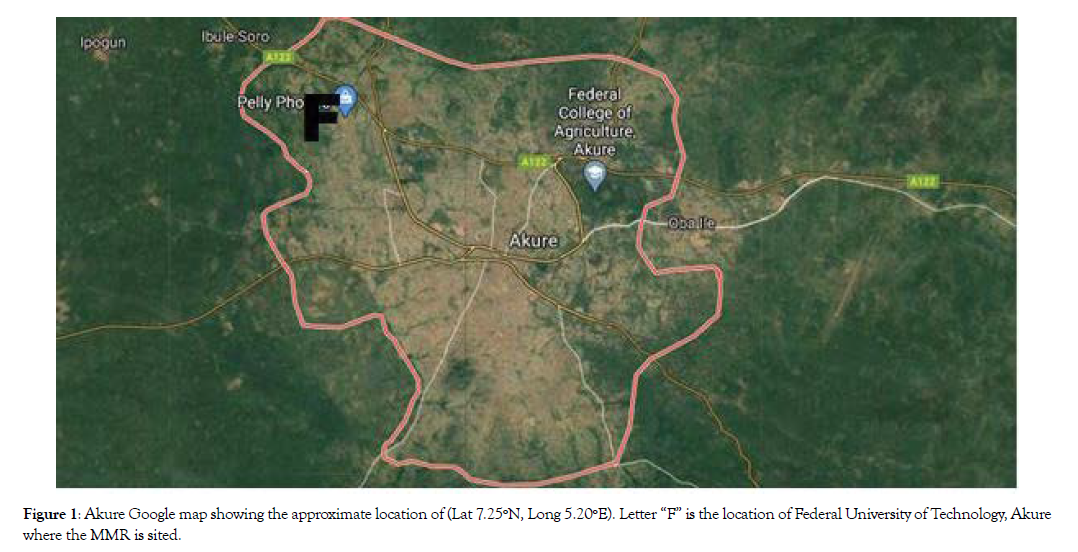
Figure 1: Akure Google map showing the approximate location of (Lat 7.25oN, Long 5.20oE). Letter “F” is the location of Federal University of Technology, Akure where the MMR is sited.
Radar specifics, measurement site and method of dust estimation
Ka –band weather radar having technical characteristics shown in Table 1 was installed at the communication and research measurement site in the campus Federal University of Technology, Akure, Nigeria. There are some radar bands are actually not suitable for dust pollution detection. For example, Goldhrish [14] argued that attenuation of radar signal as at L -band may be considered negligible, meaning that such radar system may not detect dust accurately. Dust attenuation at Ka radar frequency is very high; dust detection using this band is also expected to increase in accuracy. The equipment at our site is 8 cm wavelength vertically pointing, MMR-2 radar, shown in Figure 2, which measures reflectivity at 64 spectral frequencies. The radar was configured to a vertical range resolution of 30 m and Pulse Repetition of 0.2 microseconds. The site is a tropical location that often experiences severe dust pollution during the boreal winter. During this period the Sahara dust migrates from the source regions of Faya Largeau, Bodele depression and parts of Western Sahara desert aided by dry but strong north easterly winds to the coast of Atlantic Ocean and beyond. In the process of dust migration, visibility downwind is always very poor with attendant hospitalization for respiratory related diseases. Goudie and Middleton [15] estimated that between 130 and 760 Tgyr-1 of dust are transported across West Africa. Weather over the site is also influenced by wet south westerly wind flow during the rainy season emanating from the Atlantic coast and extending to the fringe of Sahel savanna between March and September on annual cycle. Dust pollution during the rainy season is low and is mainly due to local sources.
| Radar system Characteristics |
Radar Ka- band |
Radar S- band |
Radar C- band |
Radar X- band |
|---|---|---|---|---|
| Band | K | S | C | X |
| Frequency | 24.23GHz | 2.70 – 2.90 GHz | 5.45 – 5.82 GHz | 9.375 GHz |
| Transmitter | Gunn-diode | Magnetron | Magnetron | Magnetron |
| Transmit Peak Power | 50 mW | 600 kW | 250 kW | 50 kW |
| RF Pulse Width | 0.2 µs | 0.8 -2 µs | 0.5 -2 µs | 0.5 -2 µs |
| PRF | 125,000 Hz | 250-5000 Hz | 250-2500 Hz | 250-2500 Hz |
| Antenna Type | Circ parabolic | Circ parabolic | Circ parabolic | Circ parabolic |
| Antenna Gain | 40.1 dB | 45 dB | 45 dB | 41.6 dB |
| Polarization | Linear H | Linear H | Linear H | H and V |
| Beam Width | 2.0o | 1.0o | 1.0o | 1.3o |
| Reflector diameter | 0.6 m | 8.5 m | 4.2 m | 2.1 m |
| Sensitivity (MDS) | -37 dBm | -113 dBm | -113 dBm | -112 dBm |
| Receiver Noise Figure | 2 dB | 2 dB | 2 dB | 2.3 dB |
Table is modified after Marzano, with inclusion of K-band radar characteristics.
Table 1: Technical characteristics of the Ka-band radar compared to other radar bands.
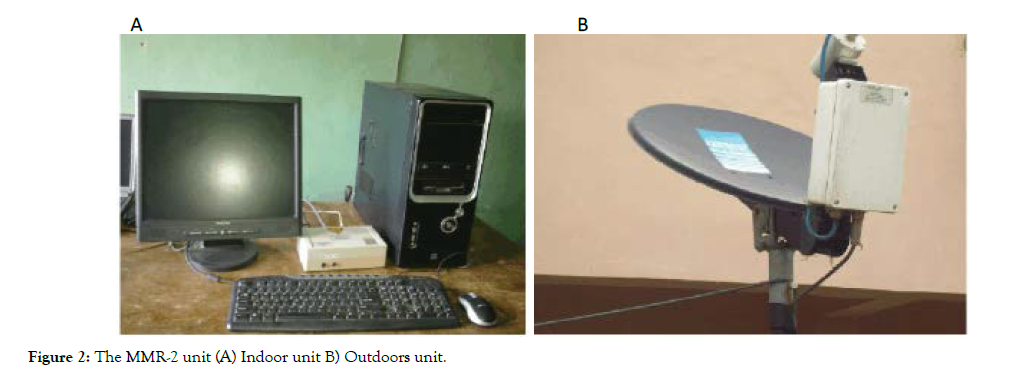
Figure 2: The MMR-2 unit (A) Indoor unit B) Outdoors unit.
Expression for derivation of dust pollution
Dust particles are capable of reflecting electromagnetic wave
sent out from radar back to the earth. This backscatter echo  is related to the diameter spectrum of dust particles
is related to the diameter spectrum of dust particles and can be expressed as in equation 1.
and can be expressed as in equation 1.

where  is the probability that dust particle
diameter lies within dust diameter spectrum per meter
square otherwise known as particle probability. Zhang et al.
[16] has shown that
is the probability that dust particle
diameter lies within dust diameter spectrum per meter
square otherwise known as particle probability. Zhang et al.
[16] has shown that  dust particle spectrum
diameter
dust particle spectrum
diameter  and total number of particles
and total number of particles are related by;
are related by;

Combining equations (1) and (2) yields the relationship
between echo power  particle probability
particle probability total number of particle
total number of particle and the echo power per each particle
and the echo power per each particle is expressed
in equation 3 according to Wang et al.[17];
is expressed
in equation 3 according to Wang et al.[17];

The density of dust particle is an important parameter, which
indicates turbidity status of the atmosphere during a dust event and
it is a measure of horizontal poor visibility. The relationship between
density  and dust probability
and dust probability can
be expressed as [14];
can
be expressed as [14];

Mass loading of dust is directly related to the dust density  and probability
and probability 

where is the dust particle density assumed to 2.6 gm/cm3, and the
value of  has been inferred from the work of
Ghobrial [18] who measured particle size distribution for four
dust storm events in Khartoum (Sudan). Based on various particle
diameter distributions, Goldhrish [14] calculated the mean dust
probability and found that
has been inferred from the work of
Ghobrial [18] who measured particle size distribution for four
dust storm events in Khartoum (Sudan). Based on various particle
diameter distributions, Goldhrish [14] calculated the mean dust
probability and found that  is 3.48×10-5 (mm)3.
is 3.48×10-5 (mm)3.
Substituting these values into equation (5), it can be shown that the mean dust mass loading (gm/ m3) is;

Wang et al. [17], using radar data over the Taklimakan desert, also showed that mass concentration M (μg/m3) of dust could be expressed in term of radar reflectivity in form of Z-M relationship given in equation (7);

where A and b are constants whose values are 22,988.3 and 1.006
for a floating dust. Equations 6 and 7 can be combined to find
the relationship between radar reflectivity Z and dust total density  by adjusting the equation to have the same unit
and noting that dust mass loading and dust mass concentration
are the same, accordingly dust total density
by adjusting the equation to have the same unit
and noting that dust mass loading and dust mass concentration
are the same, accordingly dust total density  can be
expressed as;
can be
expressed as;

Finally, we obtained the visibility, Vx (km) from the expression
in equation 9 according to Goldhrish [14]. Equation 9 relates the
visibility with particle density and particle radius
r, which allows radar estimation of dust profile. Vertical profile
of dust allows the forecasters to make accurate forecast about
dust episode by knowing the dust thickness at each layer in the
atmosphere. This method can be incorporated into radar computer
algorithm which will gives final output of dust profile.
and particle radius
r, which allows radar estimation of dust profile. Vertical profile
of dust allows the forecasters to make accurate forecast about
dust episode by knowing the dust thickness at each layer in the
atmosphere. This method can be incorporated into radar computer
algorithm which will gives final output of dust profile.

An average value for particle size diameter of 0.0005 mm [19] has been used in consistency with mean dust probability over West Africa.
Visibility records usually made by observers at meteorological stations are based on visual inspection and are quite subject to the personal judgment of the observer and are limited to few vertical distances in meters. However, it can be used to the determine presence of dust load in the atmosphere. So in this paper, we have explored the use of radar reflectivity data to determine visibility and compare results with those “observations”.
This is possible because reflectivity is the radar signal obtained after the initial signals sent out by the radar hit certain object (in the case dust particles) and scattered back to radar receivers at the base station. The scattered signal is a direct function of dust load in the atmosphere. So when many dusts are present in the atmosphere more signals is scattered and reflectivity is high. This relationship is explored here and we found that it has a very good correlation with observed visibility from observers’ record as shall be shown later.
Ground-based visibility, TOMS and Aqua terra AOD
Ground-based visibility data of year 2014 on daily basis, corresponding to period of radar data, were obtained from the archive of OGIMET SYNOP (https://www.ogimet.com/) over Akure. OGIMET SYNOP is a summary of daily weather for several countries of the world recorded in World Meteorological Organization (WMO) international code format. Apart from dust, several other atmospheric constituents may be attributed to a reduction in visibility such as heavy rainfall and fog. However, during the dry season over West Africa, poor visibility is majorly caused by dust incursion. Thus, the focus of the study shall be on the dry period when there was prevailing dust circulation in the atmosphere. Ozone Monitoring Instrument (OMI) on aboard the NASA Earth Observing System (EOS) Aura satellite also provides a measure of atmospheric dust in form of UV absorbing aerosol index (UV_AI). OMI data was designed to continue the long-term records of Total Ozone Mapping Spectrometer (TOMS). Kroon et al. [20] compared TOMS and OMI data products and found that up to 99% correlation exists between the two datasets and therefore complementary. UV_AI value could range between 0 and 6. Higher values of 3 and above indicate high dust concentrations in the atmosphere [21]. Moderate Resolution Imaging Spectroradiometer (MODIS) is an instrument on board of the Terra (EOS AM) and Aqua (EOS PM) satellites. Aerosol Optical Depth (AOD 550 nm) from aqua terra is another index that indicates the presence of dust in the atmosphere. Details description of MODIS AOD which include spatial resolution and retrieval error estimate can be found in Ridley et al. [22]. Both UV_IA and AOD 550 nm level 3 data were obtained from NASA gridded data interface (Giovanni https://giovanni.gsfc.nasa.gov/giovanni/) at daily time resolution and extracted for the study location.
Visibility observation
Horizontal visibility range (visual distance from the observer) has a direct relationship with the amount of particulate matters in the atmosphere. Anuforom et al. [6] categorized amount of dust in the atmosphere based on visibility range as Thick dust occurrence (THD) when visibility is ≤ 1,000 m, Light dust haze when visibility is ˃1,000 m and visibility ≤5, 000 m and clear atmosphere when visibility is > 5000 m. This categorization, which has been used also by other researchers such as Goudie et al. [15] and Engelstaedter et al. [23], applies only during the dry season when atmospheric dust accounts for almost all cases of turbidity in the atmosphere. In Table 2, daily frequency of occurrence of visibility is presented which showed that THD occurred only in January four times and once in February. However, LHD occurrence was more frequent in the month of January, February, August October and December. Since thick dust occurrence over Akure is very rare in August and October, only January, February, March and December poor visibility is attributable to dust occurrence. The total number of time when both THD and LHD occurred in January and December was 39 days out of 61 days with January as the haziest month of the year, having a mean visibility range of about 4 km. During those times, frequent flight delay and cancelation could occur with attendant loss of productive time and income. It should be noted that the visibility observation present here does not include the profile of atmospheric dust, as visual observations cannot sufficiently estimate dust profile. Dust accumulation during the dry season occurs at such height above the ground that visual observation might not adequately capture for recording. Due to atmospheric mixing, accumulated dust could descend rapidly within short time resulting into visibility deterioration. This situation usually is unpredictable using visual observation. However, radar profile measurements would capture dust accumulation above the ground, thus making occurrence of dust prediction possible and increase the reliability of ground observation especially for flight operations.
| Months | 100-1000 (m) | 1001 -5000 (m) | 5001 (m) and above | Total | Mean (km) |
|---|---|---|---|---|---|
| January | 4 | 21 | 6 | 31 | 4.03 |
| February | 1 | 7 | 20 | 28 | 7.90 |
| March | 0 | 6 | 25 | 31 | 9.00 |
| April | 0 | 0 | 30 | 30 | 12.3 |
| May | 0 | 0 | 31 | 31 | 12.9 |
| June | 0 | 0 | 30 | 30 | 12.1 |
| July | 0 | 0 | 31 | 31 | 10.5 |
| August | 0 | 4 | 27 | 31 | 9.20 |
| September | 0 | 0 | 30 | 30 | 10.8 |
| October | 0 | 1 | 30 | 31 | 10.7 |
| November | 0 | 0 | 30 | 30 | 11.1 |
| December | 0 | 14 | 17 | 31 | 6.82 |
Table 2: Visibility categorization based on frequency of occurrence using the daily data of year 2015
Radar measurement of visibility
Based on equation 9, radar-derived visibility was obtained as shown in Figure 3 (upper panel). This figure illustrates the time evolution of dust occurrence during the course of a day on January 1, 2014. It also showed the profile of visibility between the ground and a range of about 4 km. Visibility on this day varies between from 8 km close to the surface, to 12 km at an altitude of about 1000 m. It is clear that visibility was rather poor in the morning hours recording about 8 km but improved during the afternoon hours to about 10 km and later became poor in the evening hours. This was also shown in lower panel of Figure 3, that, between the hours of 900 GMT and 1800 GMT there was an improved visibility. This diurnal dust characteristic is an obvious feature of dusty atmosphere during the dry season over tropical West Africa and has direct relationship with the evolution of Atmospheric Boundary Layer (ABL) over the region. During the hours of night and early morning, ABL is shallow and typically much dust is retained in the lower atmosphere resulting into pollution. As the ABL deepens during the later morning around 1000 GMT due to convection, dust pollution is lifted leading to improved visibility. Convection becomes weakened during the evening hours and ABL depth becomes shallower resulting into dust pollution in the lower atmosphere close to ground level.
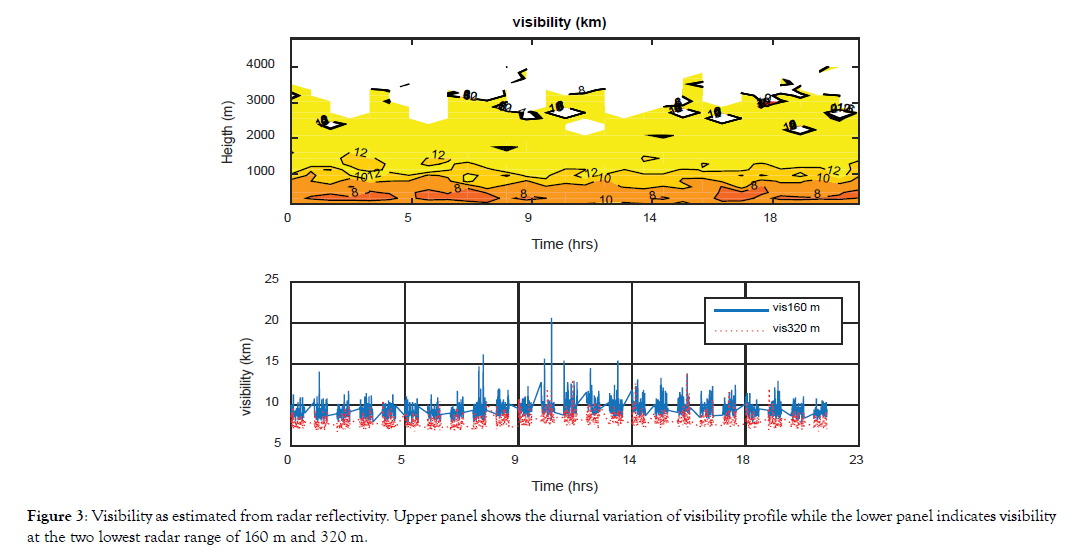
Figure 3: Visibility as estimated from radar reflectivity. Upper panel shows the diurnal variation of visibility profile while the lower panel indicates visibility at the two lowest radar range of 160 m and 320 m.
Comparisons between Radar, observed visibility, OMI UV aerosol index and MODIS AOD 550 nm
Radar-derived visibility was compared with some atmospheric aerosol indices OMI_AI and MODIS AOD) and also with observed visibility. Availability of fairly complete dataset dictates the choice of period for this comparison. We found the month of December 2014 most suitable as both radar and observed visibility have only one missing day, thus comparison is based on 30 days of continuous data. In Figure 4, a temporal variation for month-long data is presented. Observed daily visibility at 9:00 AM shows clear visibility in the first 8 days recording up to 16 km and deteriorates thereafter to poor visibility of about 6 km. Radarderived visibility followed the observed visibility closely showing similar pattern. However, records of MODIS AOD and OMI_ AI deviate significantly from both observed and radar—derived visibility. Nevertheless, both MODIS AOD and OMI_AI show similar patterns. The reason for lack of correspondence between observation and the satellite-derived dust indices could be due to several factors such inconsistent time between satellites over-pass and observation as well as location factor. It has been show by Anuforum et al. [6] that corresponding between UV_AI is very good in the Sahel region of West Africa where the dust circulating in the region emanates from, but decreases in accuracy towards the cost of Gulf of Guinea (GoG). Accordingly, in Akure, a tropical rainforest location at the fringe of GoG, lack of correspondence may be expected. Extraction of dust indices for single station is generally less accurate than area or regional average and this may have affected it synchronization with single station observation. During the period, both MODIS AOD and OMI-AI show moderate dust concentration corresponding to 2.5 AI and 1.3 AOD. Correlation between observed and radar-derived visibility is 0.81 as presented in Figure 5. Similar correlations between observed visibility and AOD and OMI-AI are rather poor for obvious reasons. However, we observed that correlation between MODIS AOD and OMI_AI is very high (0.76), an indication that the two datasets could supplement each other.
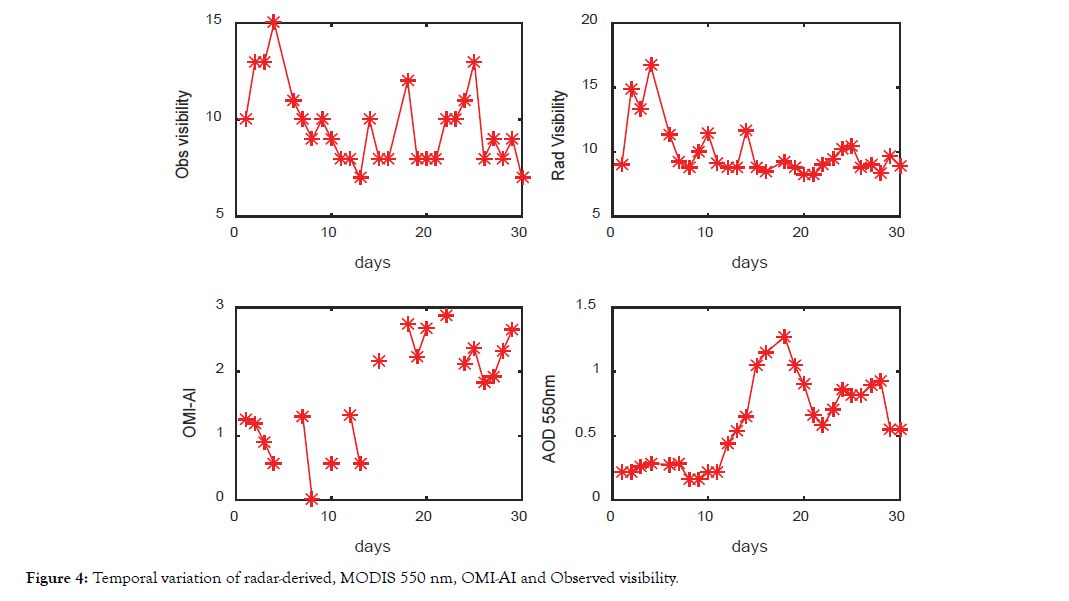
Figure 4: Temporal variation of radar-derived, MODIS 550 nm, OMI-AI and Observed visibility.
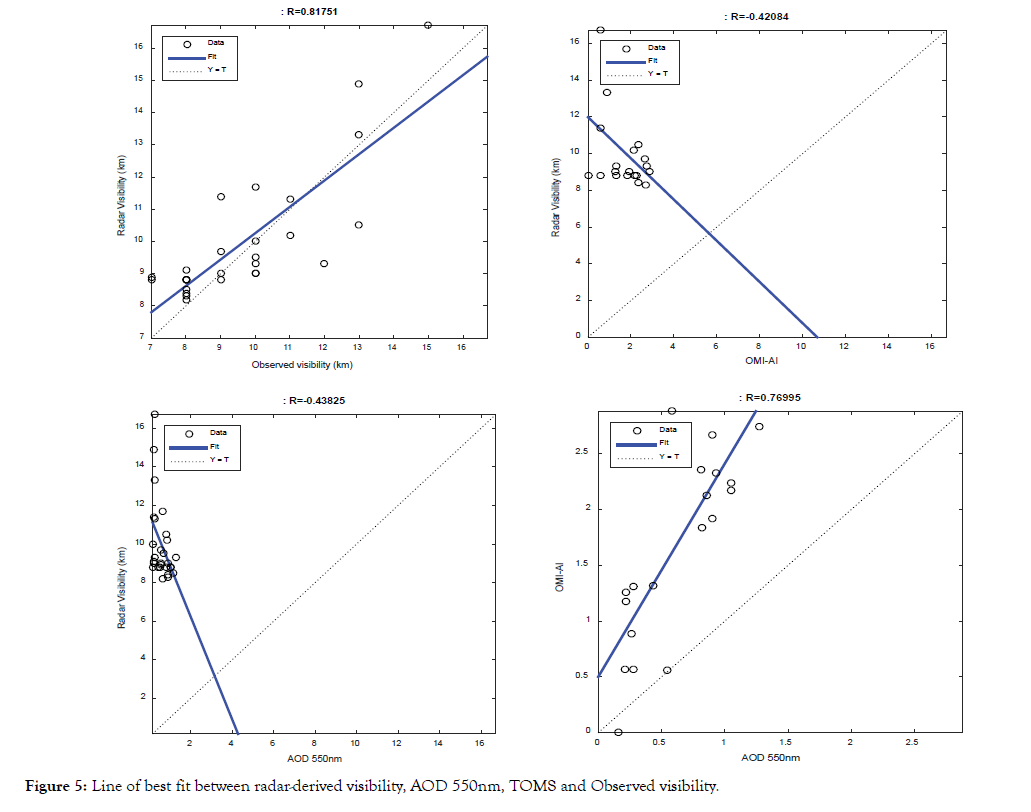
Figure 5: Line of best fit between radar-derived visibility, AOD 550nm, TOMS and Observed visibility.
This study focused on detection of dust pollution using radar reflectivity during the dry season in a tropical location in West Africa. Using ka-band radar characteristics, this paper has demonstrated a method through which dust pollution can be detected from the relationship between atmospheric dust load and radar reflectivity. The result from this method was compared with actual visibility observation and a very good agreement was found with correlation coefficient of 0.81. Since radar signal could reach deeper into the atmosphere, profile of dust pollution in the atmosphere could also be made from radar reflectivity. Consequently radar-derived visibility measurement offers a unique advantage over visual observation of visibility by providing layer-bylayer details of dust in the atmosphere and enhances prediction of dust occurrence or clearing for aviation purposes among others.
The authors declare that they have no known competing financial interests or personal relationships that could have appeared to influence the work reported in this paper.
The author wish to thank research team at the department of Physics, Federal University of Technology, Akure for making available the radar data used for this study. Many thanks are also due NASA data processing team for MODIS and OMI data.
Citation: Oluleye A, Ojo JS (2020) Detection of Dust pollution using a Ka-Band Doppler Radar in a Tropical Location of West Africa. J Pollut Eff Cont 8:241. doi: 10.35248/2375-4397.20.8.241
Received: 16-Mar-2020 Accepted: 09-Apr-2020 Published: 16-Apr-2020 , DOI: 10.35248/2375-4397.20.8.241
Copyright: © 2020 Oluleye A, et al. This is an open-access article distributed under the terms of the Creative Commons Attribution License, which permits unrestricted use, distribution, and reproduction in any medium, provided the original author and source are credited.